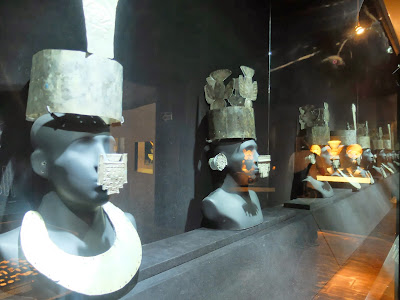Left: View of Larco Museum Entrance from Garden;
Middle: Chimu Idol - Imperial Epoch;
Right: Shelves in the Pottery Storeroom
After our trek to Machu Picchu, we spent a few days in Lima. One of the places we were eager to visit was the Museo Larco and we were not disappointed. We spent about five hours there which included a leisurely lunch in the museum café.
The museum setting, a 18th century vice-royal building and a central garden area, is just the kind of ambiance you might need to take a break from the hustle and bustle of Lima. The museum was founded in 1926 by Rafael Larco Hoyle (1901 – 1966), who is considered as one of the founders of Peruvian archaeology.
A cool fact: Before radiocarbon dating was invented (1949), Larco Hoyle proposed a chronology of pre-Columbian cultures based on the El Niño phenomenon, which occurs every 18 to 25 years. With the phenomenon, the Peru coast get torrential rains that lead to a distinctive alluvial deposit for each event. Counting the layers, he developed a way to place the different Peruvian cultures in time. This chronology is the starting point for you visit in the museum (also here on online). It’s a grid with locations in Peru (north, central, coast, mountains) for the columns, and “Peruvian Epochs” for the rows. Note that the Inca are in the second row, the Imperial Epoch.
Left: Peruvian Pre-Columbian Cultures; Right: Three Pitchers (Urpus)
In one sense, the museum isn’t large, but in another sense, there is a lot to engage visitors interested in learning more about ancient Peruvian cultures. The explanations in the permanent exhibition space are excellent and are provided in six languages (Spanish, English, French, Italian, German, and Japanese). One of the rooms of the exhibition spaces is a reference room where you can relax for a few moments, review one of many reference books, or use a computer to view the online catalog.
Speaking of online catalog, kudos to the museum’s website, which is one of the best I’ve encountered. It’s informative and allows you to get details (images included) of pieces you might have seen. The interactive map of the permanent exhibit lets you choose a room and a location in the room to view the items there. (For information wonks like us who want to reconstruct the details of what we saw, this is heaven.) The museum’s pieces can also be viewed in Google’s Art Project, which provides a compelling way to browse the collection.
Other parts of the museum to not miss: the erotic gallery and the pottery storeroom. The erotic gallery is located near the café in two rooms, separate from the main gallery. The pottery storeroom, is just off the main reception courtyard, and is mind-boggling in that you are allowed to visit it and for its orderly shelves of 35,000 pieces of pottery.
Left: Chimu Metal Work; Right: Gold Headdresses Moche, Florescent Epoch (1 AD - 800 AD)
Left: View of Central Garden in the Larco Museum; Right: Pottery Storeroom - Mochica Portrait Ceramics
The Storeroom, the Other 95% of the Collection





.JPG)




No comments:
Post a Comment
All comments are moderated. If your comment doesn't appear right away, it was likely accepted. Check back in a day if you asked a question.